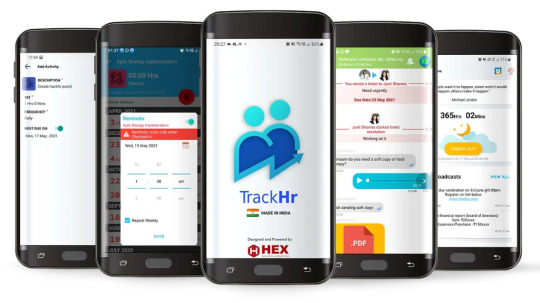#Human Resource Management System
Explore tagged Tumblr posts
Text
#payroll software#payroll software in india#hrandpayrollsoftware#human resource management system#erecruitmentmanagement#online payroll software#ess management software#leave and attendance software in delhi#employee self service#grievance management system
0 notes
Text

Transform Your Workforce into a High-Performance Engine with HREasy
At Byte Elephants Technologies, we believe your people are your greatest asset. That’s why we developed HREasy—a smart, integrated Training and Performance Management System designed to drive productivity, efficiency, and business growth.
✅ Define & track KRAs/KPIs with precision ✅ Enable multi-level, 360° performance reviews ✅ Automate training needs through skill-gap analysis ✅ Align training programs with business goals ✅ Empower continuous improvement with real-time insights
Whether you're aiming to optimize talent, boost ROI on HR investments, or build a future-ready leadership pipeline, HREasy makes it possible—seamlessly.
0 notes
Text
AI Driven Human Resource Management System for Business Growth | YOOV
YOOV’s AI-powered human resource management system helps businesses automate routine HR tasks, gain insights from employee data, and enhance decision-making at every level.YOOV provides a scalable human resource management system that simplifies HR for small to mid-sized businesses. Save time, reduce manual work, and stay organized.
0 notes
Text
Why Every Growing Business Needs HRMS Software India?
Introduction
As businesses expand, managing HR processes manually becomes a challenge. Payroll errors, compliance issues, and inefficient employee management can slow down growth. This is where HRMS Software in India comes into play. It automates key HR functions, reduces administrative workload, and ensures regulatory compliance. From payroll processing to employee attendance tracking, an efficient HRMS software helps businesses optimize their workforce and focus on strategic goals.

The Growing Need for HRMS Software in India
A structured HR management system is crucial for businesses operating in a competitive environment. With evolving labor laws, remote work trends, and the demand for employee-centric policies, businesses need an integrated solution to handle HR functions effectively. The adoption of human resource management software has become essential to ensure accuracy, efficiency, and compliance in HR operations.
Key Benefits of HRMS Software for Growing Businesses
1. Efficient HR Process Automation
Automates essential HR tasks like payroll processing, leave tracking, and attendance management.
Reduces paperwork and eliminates human errors, ensuring seamless HR operations.
2. Centralized Employee Data Management
Maintains a secure database of employee records, including contracts, performance history, and payroll details.
Enables easy access to employee information, reducing time spent on manual record-keeping.
3. Enhanced Payroll Processing
Calculates salaries, deductions, and tax liabilities with accuracy.
Integrates with banking systems for seamless payroll disbursement.
4. Compliance with Indian Labor Laws
Ensures adherence to statutory regulations like PF, ESI, and income tax deductions.
Keeps businesses audit-ready by maintaining proper documentation and legal records.
5. Improved Employee Performance Tracking
Helps HR managers set performance benchmarks and monitor employee progress.
Enables structured appraisals and feedback mechanisms to enhance workforce productivity.
6. Better Workforce Analytics and Decision-Making
Generates detailed reports and HR analytics for strategic workforce planning.
Offers insights into employee engagement, attrition rates, and hiring trends.
Key Features of the Best HRMS Software in India
1. Advanced Payroll Management
A reliable HRMS software ensures precise payroll processing, including automated salary calculations, tax compliance, and payslip generation. The integration of payroll with attendance and leave data eliminates the need for manual calculations.
2. Comprehensive Attendance and Leave Management
With a cloud-based human resource management software, businesses can track employee attendance in real time. The system also automates leave requests, approvals, and policy enforcement, reducing administrative overhead.
3. Employee Self-Service Portal
A key feature of the best HRMS software in India is an employee self-service portal. This allows employees to update their personal details, download payslips, apply for leaves, and track performance metrics without HR intervention.
4. Performance and Appraisal Management
Performance reviews are simplified with a structured approach to tracking goals and feedback. HRMS Software in India enables organizations to set key performance indicators (KPIs) and automate appraisal processes for better talent management.
5. Seamless Recruitment and Onboarding
Hiring the right talent is crucial for growth. A modern HRMS software streamlines the recruitment process by integrating job postings, resume screening, interview scheduling, and onboarding formalities in a single platform.
Choosing the Right HRMS Software in India
1. Identify Business Needs
Before selecting an HRMS software, businesses should evaluate their specific HR challenges. Understanding requirements like payroll automation, compliance management, and employee engagement tools helps in choosing the right solution.
2. Compare HRMS Providers
Researching and comparing the best HRMS software in India ensures businesses get a cost-effective solution that meets their needs. Key factors to consider include ease of use, scalability, customer support, and integration with existing business tools.
3. Assess Data Security and Compliance
Since HR data includes sensitive employee information, organizations must choose human resource management software with robust security protocols. Ensuring compliance with Indian labor laws and data protection regulations is essential.
4. Prioritize User Experience and Implementation Support
An intuitive interface and seamless implementation reduce the learning curve for HR teams and employees. Selecting an HRMS software in India that offers training, customer support, and customization ensures long-term efficiency.
Conclusion
For growing businesses, investing in HRMS software in India is a strategic move that enhances efficiency, ensures compliance, and streamlines HR operations. By automating payroll, attendance, and performance tracking, businesses can reduce administrative burdens and focus on long-term growth. The adoption of the best HRMS software in India allows organizations to manage their workforce more effectively while maintaining compliance with labor laws. Businesses looking to optimize their HR processes should explore advanced human resource management software that aligns with their operational needs and future expansion goals.
#HRMS Software in India#HRMS Software#Free HRMS#Human Resource Management System#HRMS#HRMS Software India#Best HRMS Software
0 notes
Text

#Human Resource Management System#Face Recognition Attendance System#HR Payroll Management System#Remote Workforce Management System#Field Force Management System#Contract Workers Management System#Employee Expense Management System#Overtime Tracking and Management System#Employee Performance Management System#Employee Onboarding and off boarding System#Employee Shift Scheduling System
0 notes
Text

Digitalize HR Operations with Ecuenta Human Resource Management Systems
We at Ecuenta are aware of the difficulties involved in managing human resources. For this reason, we created the Ecuenta HRMS, which is intended to improve staff management and streamline HR procedures. Our platform's robust, intuitive UI completely changes how you manage employee data, leave scheduling, document management, and employee feedback—all of which are safely accessible from any location at any time.
#hrms#Ecuenta hrms#human resource management system#Ecuenta human resource management system#hr software#Ecuenta hr software#hr software in zambia
0 notes
Text

Digitalize HR Operations with Ecuenta Human Resource Management Systems
We at Ecuenta are aware of the difficulties involved in managing human resources. For this reason, we created the Ecuenta HRMS, which is intended to improve staff management and streamline HR procedures. Our platform's robust, intuitive UI completely changes how you manage employee data, leave scheduling, document management, and employee feedback—all of which are safely accessible from any location at any time.
#hrms#Ecuenta hrms#human resource management system#Ecuenta human resource management system#hr software#Ecuenta hr software#hr software in zambia
0 notes
Text
TrackHr brings together a host of features that help to bring everyone on a single platform, automate attendance, manage work and tasks, calculate travel allowance, manage team performance and increase productivity !

#performance management system#performance management tools#team performance management#work management software#employee attendance app#attendance tracker app#task management software#task management apps#daily task tracker#human resource management system
0 notes
Text

Seamless HR Management with ImperiumCS
Imperium Corporate Services specialises in tailoring Human Resources service to align seamlessly with your company's vision and objectives. Our expert team ensures that your Human Resource Management System is not only relevant to your operations but also reflects your organization's unique standards. From updating documents to optimizing processes, Imperium provides comprehensive HR services to support your business growth effectively.
1 note
·
View note
Text

Panoramic Infotech's HR Management System streamlines workforce operations with a user-friendly interface, offering comprehensive solutions for employee data management, recruitment, and performance tracking, ensuring efficient HR processes and enhanced organisational productivity.
0 notes
Text
HRMS Integration: Challenges and their Solutions
Unlock the potential of seamless HRMS integration with these tried-and-tested solutions. Discover how to overcome challenges and streamline your HR processes. Check out our latest blog to know more: https://www.emossy.com/hrms-intergation-challenges-and-solutions/
#HRMSIntegration#human resource management system#hrms software#hr software#hrmstool#human resources#emossy
1 note
·
View note
Text

Discover Affordable and Comprehensive Payroll Software Solutions with Accent Consulting at an affordable price.
Call us today to crack the best offers @ 9999143778!
Read more steps below for Complete Payroll Software in India -
#appraisal management#performance appraisal management system#employee performance management#training management software#payroll outsourcing services#travel management software#expense management software#grievance management software#complaint management software#employee resignation management tool#letters management software#human resource management system#employee recruitment software#hr recruitment software#hr mobile software#mobile payroll software#payroll software in Faridabad#payroll software in Gurugram#payroll software
0 notes
Text

𝟱 𝗛𝗥 𝗕𝗹𝘂𝗻𝗱𝗲𝗿𝘀 𝗥𝗲𝘀𝘂𝗹𝘁𝗶𝗻𝗴 𝗶𝗻 𝗛𝗶𝗴𝗵 𝗘𝗺𝗽𝗹𝗼𝘆𝗲𝗲 𝗧𝘂𝗿𝗻𝗼𝘃𝗲𝗿 Employee turnover can disrupt operations and drain resources. Often, it’s not about employees leaving—it’s about systemic HR challenges pushing them away. Here are 5 HR blunders organizations must avoid: 1️⃣ Instinct-Based Hiring 2️⃣ Inadequate Training & Evaluation 3️⃣ Lack of Employee Engagement Tools 4️⃣ Payroll & Compliance Issues 5️⃣ No Performance Evaluation System 💡 Discover how tools like BETs HREasy HRMS can help overcome these challenges by streamlining recruitment, enhancing training, automating payroll, and building engagement.
0 notes
Text
Human Resource Management System Software for Recruitment, Performance and Leave Management Solution
HRMS software can help oversee tasks, projects, and workflows, improving productivity and reducing authoritative assignments. Payroll and HR programming can computerize different undertakings and guarantee consistency with legitimate prerequisites, saving time and lessening mistakes.
0 notes
Text
What is an HRMS System & How Does It Benefit Businesses?
Introduction
Managing human resources manually is time-consuming, error-prone, and inefficient. Businesses often struggle with payroll errors, compliance risks, and scattered employee data. This is where an HRMS System (Human Resource Management System) comes into play. It helps automate HR functions, ensuring seamless workforce management, payroll processing, and compliance tracking.
An HRMS Software is designed to simplify HR operations by integrating employee records, attendance tracking, and performance monitoring into a single platform. Whether you're a startup or a large enterprise, implementing an HRMS System in India can significantly enhance efficiency and accuracy in handling HR processes.

Core Functions of an HRMS System
1. Employee Management
Stores employee records in a centralized database
Automates onboarding and offboarding procedures
Tracks attendance, leaves, and shift schedules efficiently
2. Payroll Processing
Automates salary calculations, reducing payroll errors
Ensures compliance with tax regulations and deductions
Generates payslips and financial reports for transparency
3. Performance Management
Helps set employee goals and monitor progress
Simplifies performance reviews and appraisals
Identifies training and development needs for career growth
4. Compliance and Reporting
Ensures adherence to labor laws and corporate policies
Generates audit reports and maintains HR records securely
Reduces compliance risks by automating regulatory updates
Key Benefits of Implementing an HRMS System
1. Increased Efficiency and Productivity
Manual HR processes slow down operations and increase the risk of errors. An HRMS System automates repetitive tasks like attendance tracking and payroll calculations, allowing HR teams to focus on strategic initiatives. With a well-integrated HRMS Software in India, businesses can save time and reduce administrative burdens.
2. Improved Employee Experience
Employee self-service portals in an HRMS Software allow staff to check their payslips, request leaves, and update personal information without relying on HR. This enhances transparency, improves communication, and boosts employee engagement.
3. Data-Driven Decision Making
An HRMS System in India provides real-time analytics, helping HR teams identify workforce trends, predict staffing needs, and optimize recruitment strategies. With detailed reports, businesses can make informed decisions that align with their growth objectives.
4. Enhanced Compliance and Risk Management
Managing compliance manually can lead to costly penalties. A Human Resource Management System ensures timely tax filings, maintains statutory compliance, and securely stores HR records. This minimizes legal risks and ensures businesses operate within regulatory frameworks.
5. Cost Savings and Business Growth
By reducing paperwork, minimizing payroll errors, and automating HR workflows, an HRMS Software helps businesses cut operational costs. Investing in the right HRMS Software in India leads to long-term savings while fostering business expansion.
Conclusion
An HRMS System is a game-changer for businesses aiming to enhance HR efficiency, reduce errors, and ensure compliance. Whether you're looking to automate payroll, streamline employee management, or gain valuable workforce insights, an HRMS System in India can be the perfect solution.
Explore Kredily’s feature-rich Human Resource Management System to transform your HR processes and take your business to the next level.
#HRMS System#HRMS Software#free HRMS System#HRMS System in India#Human resource management system#HRMS
0 notes
Text

#Human Resource Management System#Face Recognition Attendance System#HR Payroll Management System#Remote Workforce Management System#Field Force Management System#Contract Workers Management System#Employee Expense Management System#Overtime Tracking and Management System#Employee Performance Management System#Employee Onboarding and off boarding System#Employee Shift Scheduling System
0 notes